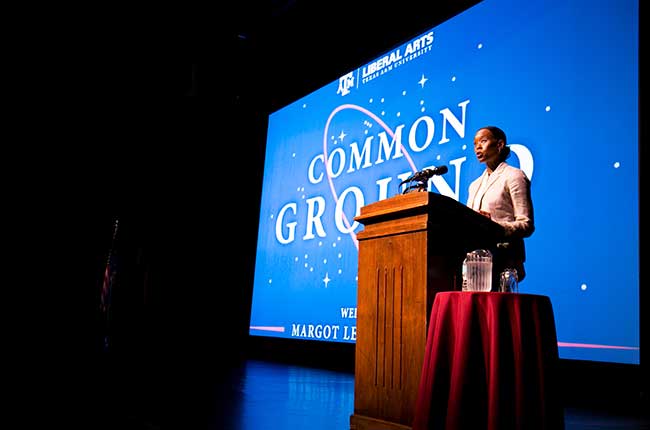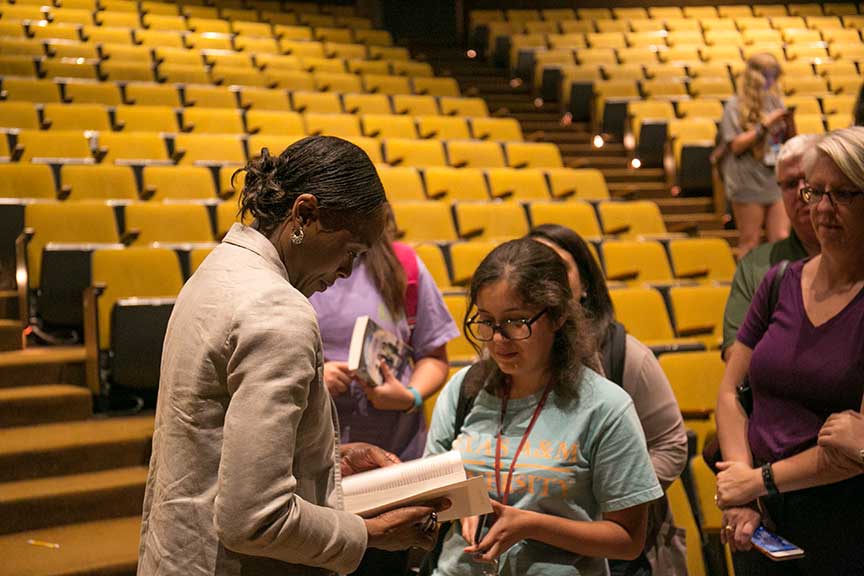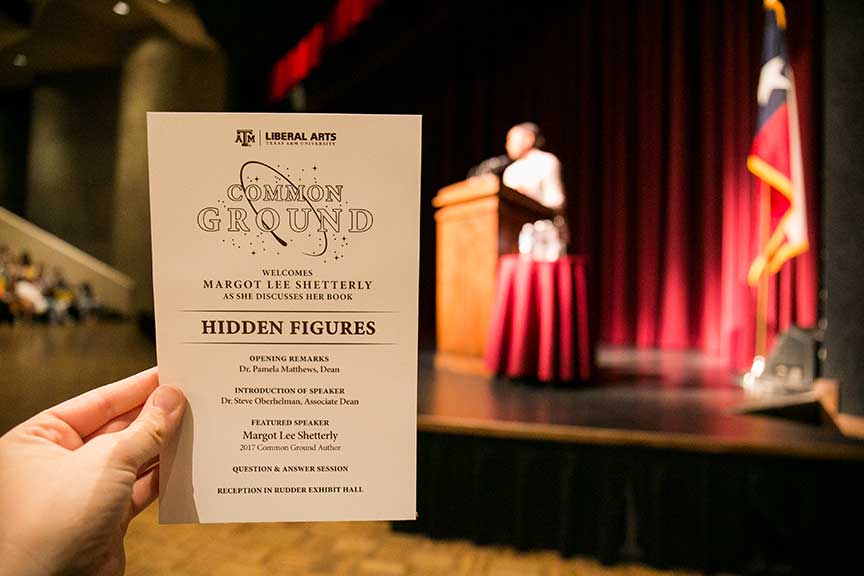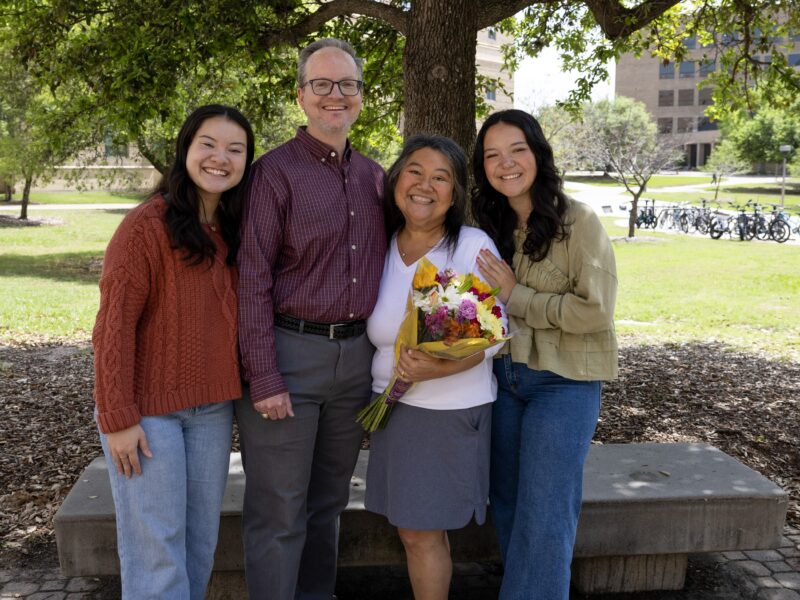Margot Lee Shetterly, the author of “Hidden Figures,” addressed an audience on the campus of Texas A&M University earlier this month about her journey as a first-time author. Her presentation was part of the 2017 Common Ground Reading Initiative sponsored by the Texas A&M College of Liberal Arts.
Shetterly’s New York Times bestselling book shares the true and untold stories of four African-American female mathematicians who were among many others working for NASA’s Langley Research Center in Hampton, Virginia in the days of the space race, between the 1950s and the 1970s.
The story attracted the attention of Donna Gigliotti, an acclaimed Hollywood producer of movies including “Silver Linings Playbook” and “Shakespeare in Love,” which led to the making of the box office hit movie “Hidden Figures” that earned more than $200 million worldwide last year.
“The only way to make the American story a true story is to make it a complete story,” Shetterly said. “The only way to do that is to understand that telling stories doesn’t fall only to the politicians, the powerful, the famous and the people at the top, but to each and every one of us.”
Shetterly, whose father was a scientist for NASA Langley and whose mother was an English professor at Hampton University, described the six-year process of researching and writing her origin story as the most rewarding work of her career. The University of Virginia graduate was an investment banker and entrepreneur before she began delving into the history of her family and their community.
Growing up in the 1970s and 1980s in the heart of the once-segregated South, Shetterly never found her story in the textbooks chronicling American history, and therefore, she avoided taking history courses in college. She could not reconcile the racial violence, disenfranchisement and shame experienced by Black Americans throughout history with her version of the American dream, and more importantly, with her version of her future.
“I grew up in a world where robust families and members of a dynamic community dreamed of a better future, and they found ways great and small to bypass injustice,” she said. “They did everything possible to help people do their best work, whether that work was cleaning other people’s houses, as my grandmother did, or calculating orbital trajectories, as did the women I wrote about in ‘Hidden Figures.’”
The coverage of African-Americans in Shetterly’s middle school history textbooks included cursory glimpses of slavery, Martin Luther King, and little else. The stories of Black Americans, like those she knew personally who were doing their best to pursue life, liberty and happiness as much as any other American, were nonexistent.
“Since my classroom days, I’ve stopped viewing history as a forced encounter with the pain of the past, but rather, I see it as the sum total of what each of us does every single day,” Shetterly said. “Knowledge of history is a prerequisite for being an informed and responsible citizen, and it’s a precursor to social progress and change…and storytelling, which is the essence of history, determines both the meaning of the past and the trajectory of our future.”
For Shetterly, recovering the stories of Dorothy Vaughn, Mary Jackson, Katherine Johnson and Christine Darden and providing them with much-deserved acclaim in their lifetimes are the most satisfying aspects of her success. NASA Langley recently dedicated its new $30 million, 40,000-square-foot data center to the 99-year-old Johnson, naming it the Katherine G. Johnson Computational Research Facility, and she attended the ceremony.
Another rewarding accomplishment for Shetterly is coining the expression, “hidden figures,” which refers to people who have contributed something to society worthy of recognition but languish in the shadows for many different reasons.
“Those two words expressed everything I wanted to say about this story,” Shetterly said. “I had been walking around for the better part of my life completely indifferent to history, and once I put on these ‘hidden figures’ glasses, I started to see all kinds of people and stories around me, hiding there in the shadows.”
The secondary narrative of “Hidden Figures” is the transformative power of education and the accomplishments possible for society when all citizens have access to a quality education, Shetterly said. Writing the book showed Shetterly the power of knowing and conveying history in a compelling way, which she said makes perfect sense considering that America is likely the only nation in the world founded by a group of writers, including Thomas Jefferson, Alexander Hamilton, James Madison and Benjamin Franklin.
“Their prose expressing ideas about the nature of humanity and freedom is some of the most admired and influential writing in the history of the world,” Shetterly said. “A good story well told can change the course of history, and no one knows that better than our founding fathers who wrote our country into existence.”
America is comprised of the lives, stories and beliefs of everyone living in the country, “no matter where they came from or how they got here,” Shetterly said. Quoting American writer and social critic James Baldwin, she said, “American history is longer, larger, more various, more beautiful, and more terrible than anything anyone has ever said about it.”
Shetterly encourages everyone to read the nation’s founding documents, including the Declaration of Independence, the Bill of Rights and the Constitution, to put on their “hidden figures” glasses as scholars and citizens, and to tell the stories of the important people standing in the wings of their lives and their histories.
“Whether our stories began with the bill of rights or a bill of sale, it is our responsibility to be the protagonists in our own stories and to write our lives into the great epic of America,” Shetterly said.
###
Media contact: Elena Watts, Division of Marketing & Communications, at 979-458-8412 or elenaw@tamu.edu; or Heather Rodriguez, Communications Specialist, College of Liberal Arts, at 979-845-6061 or hrodriguez@tamu.edu.








